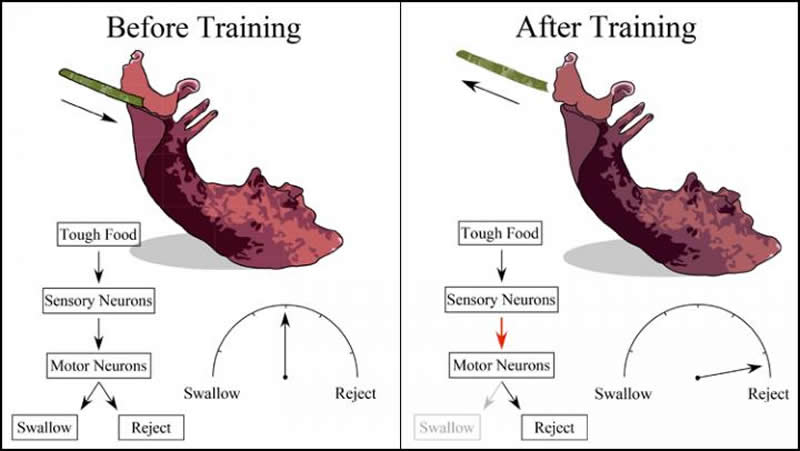Summary: Learning produces changes in connectivity via multiple synaptic mechanisms that are consistent with observed behavioral changes.
Source: SfN
Learning changes behavior by altering many connections between brain cells in a variety of ways all at the same time, according to a study of sea slugs recently published in Journal of Neuroscience. The findings offer insight into how human learning can impact widespread brain areas.
Learning influences behavior by changing the synapses, the connections between neurons. Although simple, those changes prove considerable and occur in concert in new research by Tam et al.
The researchers explored how the synapses in the sea slug Aplysia change after the animals learn to reject swallowing inedible food. The result was a widespread change in the feeding system, as the animals now rejected non-food objects as well.
In Aplysia, touch-sensing neurons form synapses with neurons that control groups of muscles responsible for feeding. After learning to reject food, synapses in this network of neurons underwent a variety of changes, both in number and amplitude. Some synapses strengthened, others weakened, and some switched between excitatory and inhibitory.

All these changes combined to increase the likelihood that the feeding muscles would now reject an object that they might previously have tried to swallow.
About this neuroscience research article
Source:
SfN
Media Contacts:
Calli McMurray – SfN
Image Source:
The image is credited to Tam et al., JNeurosci 2020.
Original Research: Closed access
“Multiple Local Synaptic Modifications at Specific Sensorimotor Connections After Learning Are Associated With Behavioral Adaptations That Are Components of a Global Response Change”. by Shlomit Tam, Itay Hurwitz, Hillel J. Chiel and Abraham J. Susswein.
Journal of Neuroscience doi:10.1523/JNEUROSCI.2647-19.2020
Abstract
Multiple Local Synaptic Modifications at Specific Sensorimotor Connections After Learning Are Associated With Behavioral Adaptations That Are Components of a Global Response Change
Learning causes local changes in synaptic connectivity and coordinated, global changes affecting many aspects of behavior. How do local synaptic changes produce global behavioral changes? In the hermaphroditic mollusc Aplysia, after learning that food is inedible, memory is expressed as bias to reject a food, and to reduce responses to that food. We now show that memory is also expressed as an increased bias to reject even a non-food object. The increased bias to rejection is partially explained by changes in synaptic connections from primary mechano-afferents to five follower neurons with well-defined roles in producing different feeding behaviors. Previously, these mechanoafferents had been shown to play a role in memory consolidation. Connectivity changes differed for each follower neuron the probability that cells were connected changed; excitation changed to inhibition and vice versa; and connection amplitude changed. Thus, multiple neural changes at different sites underlie specific aspects of a coordinated behavioral change. Changes in the connectivity between mechanoafferents and their followers cannot account for all of the behavioral changes expressed after learning, indicating that additional synaptic sites are also changed. Access to the circuit controlling feeding can help determine the logic and cellular mechanisms by which multiple local synaptic changes produce an integrated, global change in behavior.
Significance Statement
How do local changes in synapses affect global behavior? Studies on invertebrate preparations usually examines synaptic changes at a specific neural sites, producing a specific behavioral change. However, memory may be expressed by multiple behavioral changes. We report that a change in behavior after learning in Aplysia is accomplished, in part, by regulating connections between mechanoafferents and their synaptic followers. For some followers, the connection probabilities change; for others, the connection signs are reversed; in others, the connection strength is modified. Thus, learning produces changes in connectivity at multiple sites, via multiple synaptic mechanisms that are consistent with the observed behavioral change.
Feel Free To Share This Neuroscience News.






